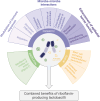Riboflavin for women's health and emerging microbiome strategies
- PMID: 39420006
- PMCID: PMC11486906
- DOI: 10.1038/s41522-024-00579-5
Riboflavin for women's health and emerging microbiome strategies
Abstract
Riboflavin (vitamin B2) is an essential water-soluble vitamin that serves as a precursor of flavin mononucleotide (FMN) and flavin adenine dinucleotide (FAD). FMN and FAD are coenzymes involved in key enzymatic reactions in energy metabolism, biosynthesis, detoxification and electron scavenging pathways. Riboflavin deficiency is prevalent worldwide and impacts women's health due to riboflavin demands linked to urogenital and reproductive health, hormonal fluctuations during the menstrual cycle, pregnancy, and breastfeeding. Innovative functional foods and nutraceuticals are increasingly developed to meet women's riboflavin needs to supplement dietary sources. An emerging and particularly promising strategy is the administration of riboflavin-producing lactic acid bacteria, combining the health benefits of riboflavin with those of probiotics and in situ riboflavin production. Specific taxa of lactobacilli are of particular interest for women, because of the crucial role of Lactobacillus species in the vagina and the documented health effects of other Lactobacillaceae taxa in the gut and on the skin. In this narrative review, we synthesize the underlying molecular mechanisms and clinical benefits of riboflavin intake for women's health, and evaluate the synergistic potential of riboflavin-producing lactobacilli and other microbiota.
© 2024. The Author(s).
Conflict of interest statement
This review was written in the framework of the PhD research projects of C.D., I.E., and S.A. However, for transparency, the authors want to declare relationships and interests that could be perceived as a potential conflict of interest. This involves the patent application EP20210606.8 that has been submitted by the host institution (University of Antwerp) on findings related to microbially produced riboflavin in strain
Figures



References
-
- Bartley, K. A., Underwood, B. A. & Deckelbaum, R. J. A life cycle micronutrient perspective for women’s health. Am. J. Clin. Nutr.81, 1188–1193 (2005). - PubMed
-
- Han, S. J. & Kim, H. W. Nutritional status and women’s Health in university students. Information20, 1795–1803 (2017).
-
- Torheim, L. E., Ferguson, E. L., Penrose, K. & Arimond, M. Women in resource-poor settings are at risk of inadequate intakes of multiple micronutrients. J. Nutr.140, 2051–2058 (2010). - PubMed
-
- Swaminathan, S., Thomas, T. & Kurpad, A. V. B-vitamin interventions for women and children in low-income populations. Curr. Opin. Clin. Nutr. Metab. Care18, 295–306 (2015). - PubMed
Publication types
MeSH terms
Substances
LinkOut - more resources
Full Text Sources

